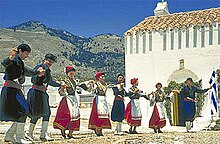Circle dance

Circle dance,orchain dance,is a style of socialdancedone in a circle or a wavy line to background music, which has a beat andsinging(sometimes just a beat without singing). It is a type of dance where anyone can join in without the need for a partner.
Unlikeline dancing,circle dancers connect with each other made by hand-to-hand, finger-to-finger or hands-on-shoulders, where they follow the leader around the dance floor. From gentle to energetic, the dance can be a fun group experience or part of ameditation.
Background
[change|change source]Being probably the oldest known dance style, it is common to many cultures for celebratingspecial occasions,religious ceremonies,and for encouragingtogetherness.Circle dances are performed to many different styles of music and rhythms. Modern circle dance mixes traditionalfolk dances,mainly from European orNear Easternorigins, with recently created ones to a variety of music both ancient and modern.[1]
Distribution
[change|change source]Modern circle dancing is found in many cultures, including Iraqi, Jordanian, Lebanese, Palestinian, Israeli, Assyrian, Kurdish, Turkish, Azerbaijani, Maltese, and Balkan.
Circle dancing also has a historical importance inBrittany,CataloniaandIrelandto thewest of Europe,and also inSouth America(Peruvian),Tibet,and withNative Americans.It is used, in its more meditating form, in worship in various religious traditions including theChurch of England[2]and the Islamic Haḍra Dhikr (or Zikr) dances.[3]
Types
[change|change source]Some famous circle dances include Hora (Balkan), Kolo (Slavic), Sardana (Italy), Syrtos (Greece), An Dro (Breton),Dabke(Levant), Khigga (Assyrian), Kochari (Caucasus,Balkan andAnatolia), Tamzara (Caucasus, Anatolia and Greece).
Related pages
[change|change source]References
[change|change source]- ↑Gilbert, Cecile (1974).International Folk Dance at a Glance(Second ed.). Burgess.ISBN978-0808707271.
- ↑"We ended with a circle dance." "A short session of circle dance was one of the activities on offer...""Archived copy"(PDF).Archived fromthe original(PDF)on 14 February 2012.Retrieved24 February2013.
{{cite web}}:CS1 maint: archived copy as title (link) - ↑Chivers, C. J. (24 May 2006)."A Whirling Sufi Revival With Unclear Implications".The New York Times.Retrieved22 April2020.
Three circles of barefoot men, one ring inside another, sway to the cadence of chant. The men stamp in time as they sway, and grunt from the abdomen and throat, filling the room with a primal sound. One voice rises over the rest, singing variants of the names of God.
